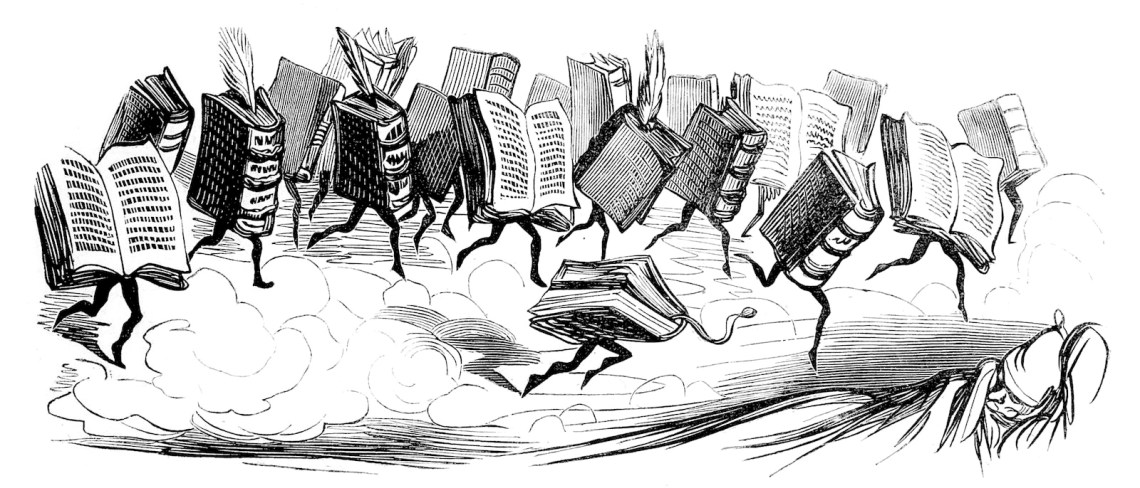I write to you with news about the state of the English major at one nonelite, midsize, regional comprehensive private university in New York City. At Pace University, where I am currently chair of the English department, the major has grown by more than 40 percent in the last two years, to around 150 students. Every year we teach some 1,600 students—majors and non-majors—in seminars and workshops on literature, creative writing, and linguistics, in addition to the five thousand we teach in composition. That’s, give or take, $30 million of credit hour revenue per year.
Our students are immersed in a curriculum that emphasizes civic engagement, creativity, and both the canon and those texts and subjects that have been marginalized by that canon. Many students research issues of local importance to our campus: the community of Black theater professionals that thrived around the corner in the 1820s, the more recent anti-gentrification movements helmed by Chinatown artists, writers, and activists. An introductory literary studies course examines changing ideas about who and what literature is for; it culminates with students working with the Bowery Residents’ Committee to organize a book drive for our unhoused downtown neighbors. Around 40 percent of our majors and alumni are Black, Indigenous, Latinx, or Asian/Pacific Islander, and many of them are first-generation college students. Excellent writers and communicators with honed skills in analysis and critical thinking, they’ve gone on to gainful employment in publishing, the arts, media, business, education, law, and the nonprofit sector. Last summer an alumna was profiled by The New York Times for her feminist video game design, much of which she credits to her poetry education. An alumnus who works as a senior editor at a big five publisher is, at the time of this writing, featured on a billboard in Times Square.
I’m reporting this good news as a counterpoint to Nathan Heller’s recent feature in The New Yorker, “The End of the English Major,” which concentrates on two universities that Heller presents as foils: Harvard and Arizona State. Heller talks to students and faculty on the two campuses in an attempt to figure out why the number of humanities degrees awarded in the US has fallen precipitously since 2012. Like other stories about the humanities at major research institutions, Heller’s article misses the fact that many regional comprehensive universities like mine have retained strong humanities enrollments, as have community colleges and HBCUs. And yet it would be naive to pretend that the crisis Heller describes isn’t important or that it isn’t related to the state of my own department. My professional experience directly contradicts the premise of Heller’s piece, but the essay also crystallized my perspective on the precarious position of the humanities in the contemporary university.
In their interviews with Heller, English faculty and administrators discuss an array of real issues with an alarming lack of coherence. They try to place blame both for what is happening at their own institutions and for what they consider broader national concerns: Middlemarch is too long for the TikTok generation; K-12 education is the problem; humanists haven’t made a strong enough case for how our areas of study prepare debt-ridden students for jobs; funding has dried up; a fusty curriculum drives students away; television exists.
Much more to the point are Heller’s interviews with students, who explain the fundamental problem quite clearly: universities do not value the humanities. This disregard is demonstrated in most universities’ built environments, real estate investments, hiring practices, staffing ratios, and unwillingness to direct resources toward the humanities even in appropriate balance with the often substantial revenue they bring in. I heard in these young people’s comments a real awareness of the funding priorities of the colleges they attend.
Students are quick to associate those priorities with their job prospects: when it comes to deciding on a major, they sense that their own personal, intellectual, and creative interests don’t really matter at all. As Ben Schmidt, a data analyst and former history professor, put it in a 2018 article on the declining number of humanities majors, “In the wake of the 2008 financial crisis, students seem to have shifted their view of what they should be studying—in a largely misguided effort to enhance their chances on the job market.” What faculty and administrators have mistaken for a problem (declining enrollments) with an identifiable cause (take your pick), students correctly see as a story being spun by the universities themselves: this area of study lacks value, is in some sense wrong. That story has become powerful enough to shape their world, restricting the number of paths presented to them as real options.
*
Recently Matt Seybold, an English professor at Elmira College, tweeted a description of how this story works. First a “forecast”—of declining enrollments, lack of interest—“is treated as a foregone conclusion,” and then “its inevitability is cited ad nauseum to justify budgeting, staffing, marketing, recruiting, etc. etc. The decisions made in anticipation of the forecasted change actually bring about the forecasted conditions.” This circular decision-making has for decades systematically starved the humanities at most higher education institutions. Christopher Newfield, the president of the Modern Language Association and director of research at the Independent Social Research Foundation, captures the basically reactive position many universities have taken in response to sweeping cultural divestment from the humanities in his essay “The Humanities Crisis Is a Funding Crisis.” The humanities are made up of a “spectrum of essential disciplines,” he writes. But “our colleges and universities do not treat them as essential…[because] college officials know that humanities research and teaching are seen as marginal to the economy.”
Advertisement
A few years ago in the journal Feminist Studies, the feminist scholars Abigail Boggs and Nick Mitchell argued that university boards and administrators have taken to shoring up their institutions by using a similarly circular “crisis consensus” as a justification for all their decisions. Assailed on all sides—by Betsy DeVos and Ron DeSantis, by student activists of all stripes, by the media, by market “demands” and federal funding restrictions—the university believes itself to be a liberal humanist good so good that its survival must be ensured by any means, even if those measures undermine its own humanist mission. That belief rationalizes whatever irrational choices the university makes. (Consider, for example, the quick capitulation of universities in Florida to state laws that violate basic academic, not to mention democratic, principles.)
The instinct is often to meet the data in a piece like Heller’s with contrary examples, as I do at the beginning of this essay, or with quibbling about that data’s inexactness. Why the emphasis on declining “shares” of majors, a somewhat meaningless statistic in the ever-expanding universe of the contemporary university? Why collapse the humanities down to a single area of study, English? (Commentators point out that English has been in decline since 2000, but that’s at least partly because many English departments have incubated other programs—including film studies, gender studies, and American studies—that are now counted separately even as they often remain symbiotic with English.) Yet this instinct replicates the logic of university administrators themselves, who encourage employees to demonstrate “data-driven” success or need in the hope that resources will follow.
But we are not actually talking about the facts or data of higher education. If we were, there might be more articles about how accounting majors are down or even glancing attention paid to the National Survey of Student Engagement’s findings that the most popular college major—business—often fails to deliver anything resembling an education to the students who’ve chosen it. Rather, we’re talking about what counts as a fact—what counts as knowledge. And neither the successes of the English major nor the desperate needs of those who are working in English departments are rising to the level of fact. It sometimes feels as if the bogeyman of relativism decried by conservatives has come home to roost only for the humanities, where it’s possible for something like a 50 percent increase in revenue to be met by a 50 percent decrease in long-term investment, as occurred in my department, where our tenure-line faculty count has shrunk from around twenty to ten in only a decade.
Some other local facts relevant to the “crisis” in the humanities: around 80 percent of my department’s curriculum is now taught by adjunct instructors who do not have offices, computers, or benefits; are not compensated for office hours or regular interactions with students outside of class and thus cannot substantially help keep these thousands of students afloat, advised, and mentored through any given semester; and who, as gig employees, are paid a rate, for all of their passion and expertise, that hovers around minimum wage. Whether an English department is thriving or dwindling, the institutional approach generally remains the same: direct resources elsewhere. Part of the problem, as I’ve seen it, is that it’s hard to demonstrate the costs of this kind of understaffing, under-resourcing, and manufactured marginality, because even under these dispiriting labor conditions faculty and students continue to fill classrooms, generate revenue, produce insights, and ignite creativity, thoughtfulness, and sophisticated habits of mind.
But these costs are real and imminent. Should my department eventually shrink by half again—a horizon that we’ll likely reach within ten years, barely enough time to get an imaginary new hire through the tenure process—we will have sustained a wholly preventable extinction event. And it will have had nothing to do with students deciding against what we’re offering, with faculty recalcitrance or resistance, with job preparedness or marketplace demands. It will be because we’ve been cast out, against our will and all our best efforts.
Advertisement
*
I have used my own professional experience as evidence because it makes for an interesting limit case: a vibrant major that is growing, in contrast to national trends. I feel lucky and proud to work where I do, at a teaching university with close ties to the arts and cultural institutions of our city. The arts and humanities have generally found support at Pace. But there is a distinction between institutional encouragement, respect, and recognition of our efforts—which I do feel grateful to have in the form of awards, event funding, and supportive messages—and long-term institutional investment, which we have not seen in over a decade. Our example reveals the limits of the approach that many institutions have taken toward this “crisis”: faculty are told to do more with less, shift disciplinary methods, market better, demonstrate our value. Our value is without question, but our survival is not guaranteed.
This semester I’m teaching my Young Adult Fiction class, in which students—many of them working full-time jobs—read almost a novel a week, half from before 1900. (Move over, Harvard students who can’t handle The Scarlet Letter!) We just finished Robert Louis Stevenson’s complicated 1883 novel about adventure and imperialism, Treasure Island, and we’ve been discussing stories with beginnings that reveal their own endings, especially those in which you find out at the start that the protagonist survives, but not without sustaining some damage. (You won’t be surprised to hear that stories about young people often use this narrative strategy.)
Every person trained in humanities teaching and research knows the kinds of damage we are sustaining, from the personal (sustainable jobs have been systematically transformed into miserably underpaid and overextended ones) to the national (James Shapiro points out in Heller’s article that the “decline of democracy” over the last fifteen years follows the same downward curve as the large-scale marginalization of the humanities during the same period). And yet signs of survival are everywhere, in the people who make up these institutions, with their creative refusals and stubborn commitment to teaching and taking hundreds of thousands of classes every year about literature, language, art, and storytelling, even in the face of powerful authorities devaluing these subjects. We might find—in this instinct toward life, toward thriving—the means to resist the institutional drive toward our extinction.




